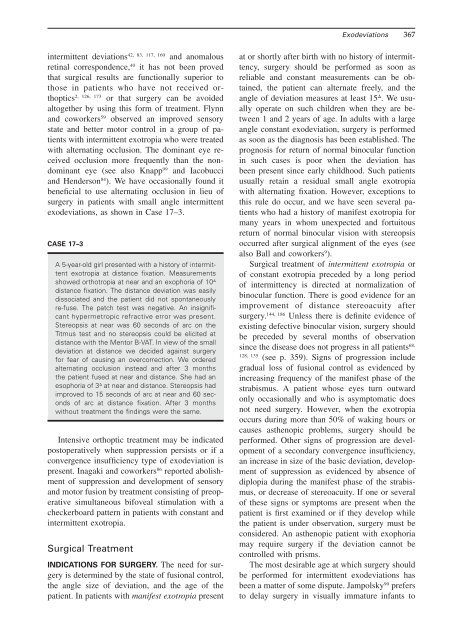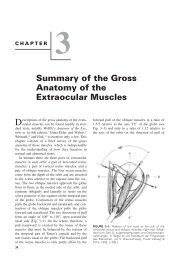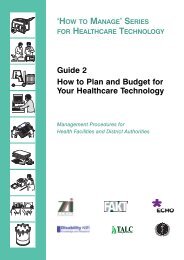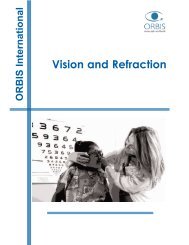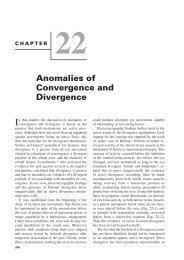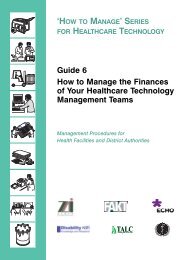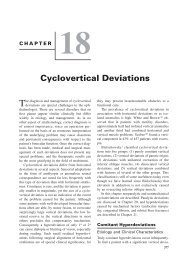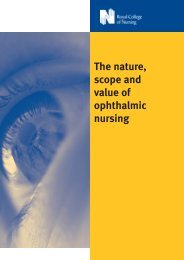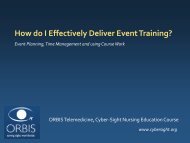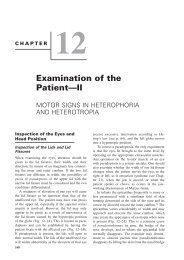Chapter 17: Exodeviations
Chapter 17: Exodeviations
Chapter 17: Exodeviations
You also want an ePaper? Increase the reach of your titles
YUMPU automatically turns print PDFs into web optimized ePapers that Google loves.
<strong>Exodeviations</strong> 36742, 83, 1<strong>17</strong>, 160intermittent deviations and anomalousretinal correspondence, 40 it has not been provedthat surgical results are functionally superior tothose in patients who have not received orthopticsor that surgery can be avoided2, 126, <strong>17</strong>3altogether by using this form of treatment. Flynnand coworkers 59 observed an improved sensorystate and better motor control in a group of patientswith intermittent exotropia who were treatedwith alternating occlusion. The dominant eye receivedocclusion more frequently than the nondominanteye (see also Knapp 99 and Iacobucciand Henderson 84 ). We have occasionally found itbeneficial to use alternating occlusion in lieu ofsurgery in patients with small angle intermittentexodeviations, as shown in Case <strong>17</strong>–3.CASE <strong>17</strong>–3A 5-year-old girl presented with a history of intermittentexotropia at distance fixation. Measurementsshowed orthotropia at near and an exophoria of 10 distance fixation. The distance deviation was easilydissociated and the patient did not spontaneouslyre-fuse. The patch test was negative. An insignificanthypermetropic refractive error was present.Stereopsis at near was 60 seconds of arc on theTitmus test and no stereopsis could be elicited atdistance with the Mentor B-VAT. In view of the smalldeviation at distance we decided against surgeryfor fear of causing an overcorrection. We orderedalternating occlusion instead and after 3 monthsthe patient fused at near and distance. She had anesophoria of 3 at near and distance. Stereopsis hadimproved to 15 seconds of arc at near and 60 secondsof arc at distance fixation. After 3 monthswithout treatment the findings were the same.Intensive orthoptic treatment may be indicatedpostoperatively when suppression persists or if aconvergence insufficiency type of exodeviation ispresent. Inagaki and coworkers 86 reported abolishmentof suppression and development of sensoryand motor fusion by treatment consisting of preoperativesimultaneous bifoveal stimulation with acheckerboard pattern in patients with constant andintermittent exotropia.Surgical TreatmentINDICATIONS FOR SURGERY. The need for surgeryis determined by the state of fusional control,the angle size of deviation, and the age of thepatient. In patients with manifest exotropia presentat or shortly after birth with no history of intermittency,surgery should be performed as soon asreliable and constant measurements can be obtained,the patient can alternate freely, and theangle of deviation measures at least 15 . We usuallyoperate on such children when they are between1 and 2 years of age. In adults with a largeangle constant exodeviation, surgery is performedas soon as the diagnosis has been established. Theprognosis for return of normal binocular functionin such cases is poor when the deviation hasbeen present since early childhood. Such patientsusually retain a residual small angle exotropiawith alternating fixation. However, exceptions tothis rule do occur, and we have seen several patientswho had a history of manifest exotropia formany years in whom unexpected and fortuitousreturn of normal binocular vision with stereopsisoccurred after surgical alignment of the eyes (seealso Ball and coworkers 9 ).Surgical treatment of intermittent exotropia orof constant exotropia preceded by a long periodof intermittency is directed at normalization ofbinocular function. There is good evidence for animprovement of distance stereoacuity aftersurgery. 144, 186 Unless there is definite evidence ofexisting defective binocular vision, surgery shouldbe preceded by several months of observationsince the disease does not progress in all patients 68,128, 135(see p. 359). Signs of progression includegradual loss of fusional control as evidenced byincreasing frequency of the manifest phase of thestrabismus. A patient whose eyes turn outwardonly occasionally and who is asymptomatic doesnot need surgery. However, when the exotropiaoccurs during more than 50% of waking hours orcauses asthenopic problems, surgery should beperformed. Other signs of progression are developmentof a secondary convergence insufficiency,an increase in size of the basic deviation, developmentof suppression as evidenced by absence ofdiplopia during the manifest phase of the strabismus,or decrease of stereoacuity. If one or severalof these signs or symptoms are present when thepatient is first examined or if they develop whilethe patient is under observation, surgery must beconsidered. An asthenopic patient with exophoriamay require surgery if the deviation cannot becontrolled with prisms.The most desirable age at which surgery shouldbe performed for intermittent exodeviations hasbeen a matter of some dispute. Jampolsky 90 prefersto delay surgery in visually immature infants to


